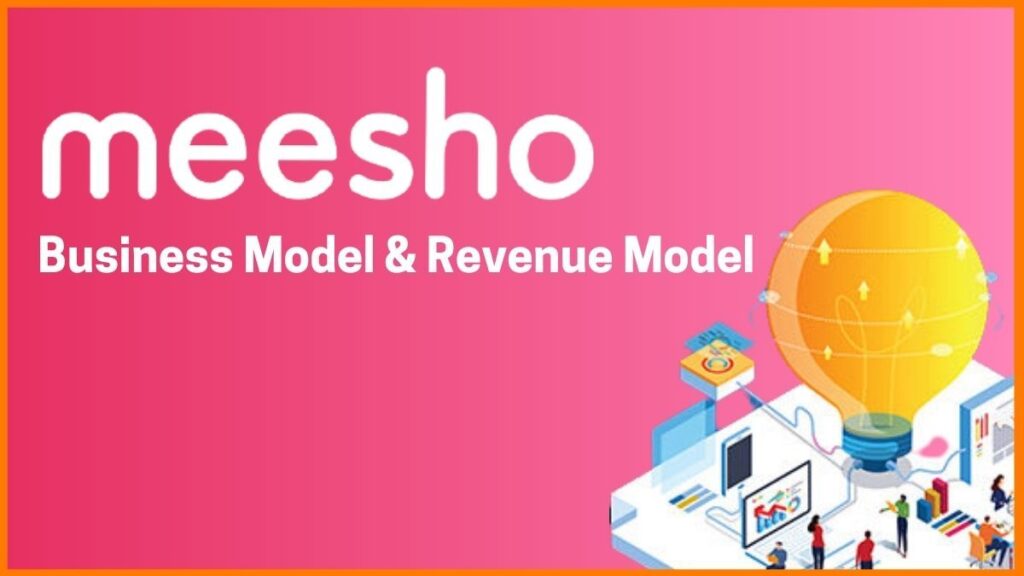Indeed, Meesho, the Indian-based horizontal e-commerce platform, has become the talk of the town with over 140 million monthly transaction users and an impressive revenue exceeding 5000 crores. Transitioning from its origins as a reseller platform to achieving the coveted status of a recognized brand is the proverbial cherry on top. This success surpassed giants like Amazon, and Flipkart in India.
Now, let’s embark on a virtual exploration of the Meesho success story, unraveling the strategies that propelled its remarkable journey…

The Origin Story Of Meesho:
In 2014, Meesho’s journey began with the venture “Fashnear,” initiated by tech graduates from IIT Delhi, Sanjeeb Barnwal and Vidit Aatrey. Despite Meesho not existing initially, the duo, inspired by Swiggy and Zomato, launched a local fashion delivery app. Following the collaborative model of food delivery giants, they partnered with local sellers to provide door-to-door delivery of fashion items.
Despite the initial failure of “Fashnear,” the founders, coming from modest backgrounds, quickly realized the appeal of fashion collections beyond local boundaries. Shifting their strategy, they targeted Tier-2 and Tier-3 cities, engaging with small businesses and boutique owners. During these interactions, a boutique owner shared the efficacy of WhatsApp for product sales, a crucial turning point for both of them.
Seizing a promising opportunity, the founders shifted to a social commerce strategy, targeting Bharat Users for tax-free online reselling. In 2015, Meesho(Meri-E-Shop) emerged as a compact version of Shopify, initially focusing on fashion reselling through WhatsApp and Facebook. This approach provided a platform for small business owners and created avenues for women’s empowerment. Evolving into a horizontal e-commerce giant, Meesho now rivals industry leaders like Amazon and Flipkart.
Meesho Business Model:

Meesho’s business model embodies a unique fusion, seamlessly blending the principles of Social Selling and dropshipping with the traditional e-commerce approach. This innovative combination allows the platform to harness the strengths of each model for a comprehensive and adaptive approach to business.
The overall business model can be understood by following simple steps:
Step-1: Sellers enlist their products on the Meesho app, and subsequently, resellers discover and engage with these listed products. This collaborative platform facilitates a seamless connection between sellers and resellers, streamlining the process of product discovery and distribution.
Step-2: The reseller, after discovering products on the Meesho app, promptly shares them within their social networking groups on platforms like Facebook, WhatsApp, or Instagram. This active sharing process amplifies the reach of the products to a wider audience, leveraging the reseller’s social connections for effective promotion.
Step-3: When a customer in the social group expresses interest in the products, the reseller seamlessly transitions to the next step, requesting the customer’s address details. This marks a pivotal point in the sales process, guiding the reseller towards facilitating the purchase through Meesho.
Step-4: After obtaining the customer’s address details, the reseller smoothly incorporates a profit margin and proceeds to place the order. This final step in the process exemplifies how Meesho empowers resellers to seamlessly manage transactions while ensuring profitability.
Step-5: Upon receiving the order, the seller promptly packs it, and Meesho’s logistic partner takes charge of delivering the products to the end users. This streamlined process ensures efficient order fulfillment and enhances the overall customer experience.
Value Proposition:
It provides value to both consumers and resellers:
- For Resellers: Meesho provides resellers a capital-free avenue to launch and expand businesses. Sellers set up brand-specific shops on the platform, sharing products on Facebook, Instagram, and WhatsApp. The company purchases goods at wholesale costs, handling logistics, packaging, refunds, and customer queries. With Meesho managing the details, resellers can focus solely on business growth.
- For Consumers: Now, only 230-250 million people in India do shop online. Because, In India, trust is a barrier for online shoppers. Meesho addresses this by connecting users with trusted resellers, reducing concerns about new platforms. Their personalized products cater to individual preferences, budgets, and locations, ensuring a secure and tailored online shopping experience.
Meesho Revenue Model:

How Does Meesho Make Money?
As Meesho works on a Zero commission policy, unlike other shopping giants it charges 0 commission on product margins, 0 penalty charge for order cancellation, late dispatch, or any other mishaps, and 0 listing fees…. Then how does the company make money??… Let’s delve into the business strategy they follow to make money.
Charging Shipping Fee:
Despite its zero-commission policy, Meesho strategically generates revenue through shipping fees. Applied to both resellers and customers, these charges are contingent on package weight and delivery area. Meesho classifies delivery areas as regional or national, determining whether shipping fees apply. This nuanced approach allows the company to cover logistical costs effectively, ensuring financial sustainability while upholding its commitment to a commission-free model.
A portion of the shipping cost is allocated to the shipping partner, with the remainder constituting the company’s profit. Nevertheless, the company incorporates the shipping cost into the final price presented to the customer. By doing so, the company enhances the appeal of the product offer, portraying it as having free shipping. This strategic approach aims to make the offer more enticing to customers.
Promoting Ads:
To boost visibility and sales for sellers, the company provides an option to run CPC ad campaigns. Interested sellers who want to promote their products can leverage this opportunity. The promoted ads, once activated, receive preferential placement in search results and gain heightened visibility on the homepage.
This increased exposure ultimately translates into more sales for the sellers. Notably, the advertisement costs incurred during these campaigns are deducted weekly directly from the seller payouts, streamlining the payment process for convenience.
Penalty:
The company enforces penalties on sellers in specific scenarios. Firstly, when customers return products, sellers are subjected to penalties. Additionally, sellers who choose the “next day delivery” option but fail to fulfill it face consequences. In such instances, sellers are obligated to pay a penalty equivalent to 2.5% of the ordered product. These measures are implemented to uphold service standards and ensure accountability within the seller ecosystem.
Furthermore, aside from the mentioned penalties, the company imposes various other charges on sellers who violate the terms outlined in its supplier agreement. These penalties are designed to uphold compliance and accountability, fostering a fair and transparent marketplace for all stakeholders involved.
Funding and Partnership:
Meesho, the e-commerce platform, recently secured an impressive funding of 1.1 billion USD through strategic investments. Key partners include Y-Combinator, Breyer Capital, Shunwei Capital Partners, Meta, Venture Highway, and the latest addition, WestBridge Capital. This substantial financial backing accelerates Meesho’s expansion, affirming its status as a prominent player in the competitive e-commerce landscape.

Meesho Cost division:
- Marketing Costs: Meesho strategically invests in marketing, employing TV commercials and offline campaigns alongside substantial online ad spending. This multi-channel approach reflects the company’s commitment to widespread brand visibility and customer acquisition.
- Technology Costs: Meesho has cultivated a robust technology team dedicated to continuous platform enhancement. This involves managing technology costs, including server expenses, CDN costs, and related infrastructure expenditures.
- Operational Costs: The business incurs day-to-day operational costs, encompassing expenses such as rent, order fulfillment, and customer support.
- Logistics Costs: Meesho shoulders the logistics costs associated with every order on its platform. Although the majority of these costs are passed on to customers, a small portion is absorbed by Meesho.
- Payment Costs: Due to its reliance on third-party payment gateways like Paytm and PhonePe, Meesho incurs a minor payment processing fee, constituting a small percentage of each transaction.
- Other Costs: This category encompasses a range of components, including employees’ salaries, legal and professional fees, and general overhead costs, etc.
Recent Changes That Made Meesho Profitable:
- Twelve to eighteen months ago, the company achieved a significant milestone by doubling its revenue. This accomplishment was coupled with a commendable reduction in operating costs, a pivotal factor contributing to the overall profitability of the business.
- They remodeled the Brand logo and added some features like Ratings, Reviews, Return policy.
- Worked on quick customer feed back.
- Then launched Industry-first-zero commission model, which is a big differentiator. That means, Small store owners uploads his products directly without paying any commission to Meesho Owners.
- Another important they have done, is more visual representation of products in the app than lengthy description.
- AI has also helped make user experience seamless.
These are the changes they have done to make company profitable which is commendable job done by founders and their teams.
Conclusion:
In conclusion, Meesho stands out as a dynamic and strategic player in the market. By employing a multi-channel marketing approach, investing in technology, and efficiently managing operational and logistics costs, the company has positioned itself for growth. With a strong focus on customer acquisition and platform improvement, Meesho appears well-poised for continued success in the evolving business landscape.